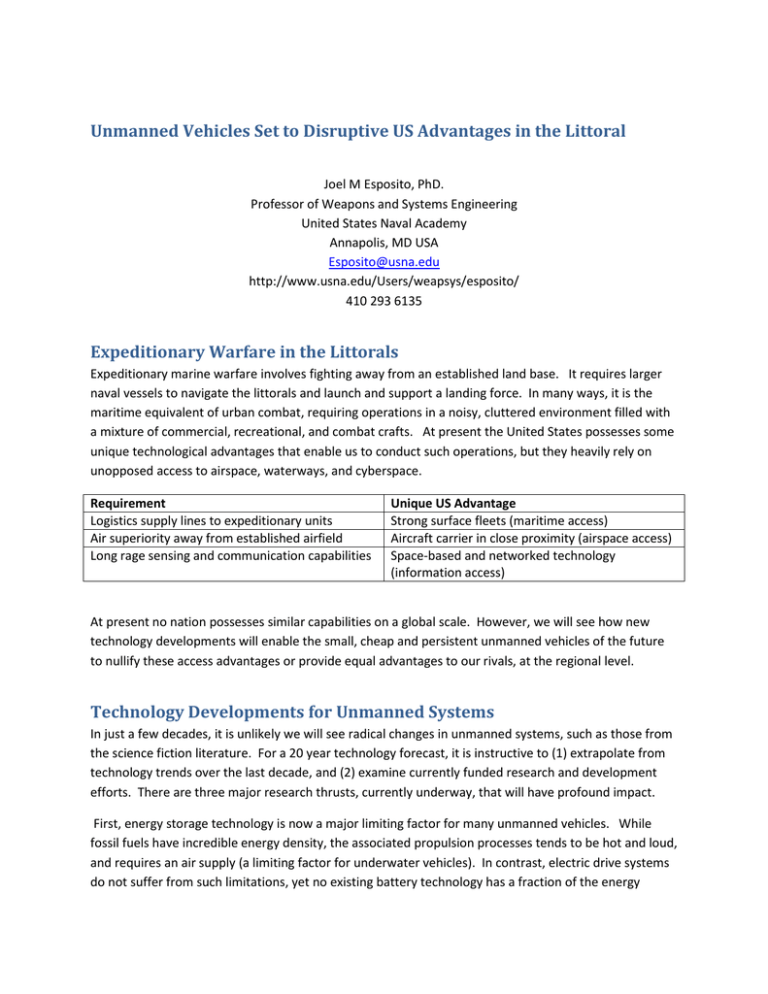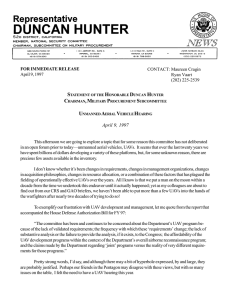Unmanned Vehicles Set to Disruptive US Advantages in the Littoral
advertisement

Unmanned Vehicles Set to Disruptive US Advantages in the Littoral Joel M Esposito, PhD. Professor of Weapons and Systems Engineering United States Naval Academy Annapolis, MD USA Esposito@usna.edu http://www.usna.edu/Users/weapsys/esposito/ 410 293 6135 Expeditionary Warfare in the Littorals Expeditionary marine warfare involves fighting away from an established land base. It requires larger naval vessels to navigate the littorals and launch and support a landing force. In many ways, it is the maritime equivalent of urban combat, requiring operations in a noisy, cluttered environment filled with a mixture of commercial, recreational, and combat crafts. At present the United States possesses some unique technological advantages that enable us to conduct such operations, but they heavily rely on unopposed access to airspace, waterways, and cyberspace. Requirement Logistics supply lines to expeditionary units Air superiority away from established airfield Long rage sensing and communication capabilities Unique US Advantage Strong surface fleets (maritime access) Aircraft carrier in close proximity (airspace access) Space-based and networked technology (information access) At present no nation possesses similar capabilities on a global scale. However, we will see how new technology developments will enable the small, cheap and persistent unmanned vehicles of the future to nullify these access advantages or provide equal advantages to our rivals, at the regional level. Technology Developments for Unmanned Systems In just a few decades, it is unlikely we will see radical changes in unmanned systems, such as those from the science fiction literature. For a 20 year technology forecast, it is instructive to (1) extrapolate from technology trends over the last decade, and (2) examine currently funded research and development efforts. There are three major research thrusts, currently underway, that will have profound impact. First, energy storage technology is now a major limiting factor for many unmanned vehicles. While fossil fuels have incredible energy density, the associated propulsion processes tends to be hot and loud, and requires an air supply (a limiting factor for underwater vehicles). In contrast, electric drive systems do not suffer from such limitations, yet no existing battery technology has a fraction of the energy storage per unit volume of diesel fuel (35.8 MJ/L). Current battery technologies are on the order of 2 MJ/ L. Furthermore, on energy per unit mass basis the comparison is even worse. Since all batteries are made using heavy metals, they are the far-and-away heaviest component of a vehicle. As battery chemistry improves, and as we adopt technologies to harvest energy in the environment, like solar, tidal and wave action, we will see a trend toward smaller vehicles, with larger payload capabilities and longer time on station. Second, at present, there are no tactical-grade navigation sensors available at the micro-scale (a.k.a. MEMS IMUs). Micro-scale sensors are fabricated using the same lithography technologies used to make computer chips, enabling the extrapolation of Moore’s Law type trends in power and production cost. In the 1990’s, when automotive manufacturers adopted MEMS based accelerometers for use in airbag safety systems, the price of these devices plummeted. Then in the 2000’s the wide-spread inclusion of IMU sensors in smart phones resulted in a similar price decrease in other navigation components. These sensors have now evolved to “industrial” quality, but are still not accurate enough to be used in “tactical grade” guidance systems. The next phase of maturation in this area will be catalyzed by the widespread commercial use of unmanned vehicles over the next decade. Once tactical grade MEMS-based IMUs are developed, they too will have a profound impact on the weight, price and power consumption of unmanned systems. The third research area, which does not directly support the “smaller, cheaper, longer” trend, is the ability to navigate in GPS-denied environments. These techniques currently exist in various early stages of technological maturity, some examples follow. Cell and radio tower signals, and even Wi-Fi signals can be used to supplement or replace GPS near shore. The ability to use bio-mimetic techniques like the optical flow based mechanisms thought to explain insect and bird navigation can provide speed over ground as well. Simultaneous localization and mapping (SLAM) algorithms discover and use naturally occurring land marks to sense ego-motion. In contrast with the space-based GPS-like systems maintained by the USA, European Union, China, India, Russia, and Japan, most of these technologies are cheap and are nearly impossible to jam or deny. They can also be used in areas where GPS signals are weak or suffer from multipath such as underwater, in caves or in the so-called “urban canyon”. As such, unmanned systems will continue to get: smaller, cheaper and have longer endurance. The causes and effects of these trends are summarized in the tables below. Smaller Vehicles Technological Causes Effects on concept of operations Major leaps in energy storage (i.e. Smaller radar and sonar signatures battery) technology Capable of operating in closer proximity Miniaturization in electronics (i.e. to US forces without detection. tactical quality MEMS inertial navigation) No crew, crew safety or life support systems Cheaper Vehicles Technological Causes Effects on concept of operations Increasing number of COTS Vehicles deployed en masse unmanned systems drives down cost Concept of operations treats vehicles as of platform expendable Open source, plug and play Unmanned vehicles available to nonnavigation systems reduce mission state actors adaption to a software problem No requirements for crew safety or life support decrease need for extensive testing Smaller size Longer Endurance Vehicles Technological Causes Effects on concept of operations Leaps in energy storage (i.e. battery) Long loiter times technology Longer range Possible hibernation modes Harder to detect due to lower heat and Ability to recharge by harvesting acoustic signature (no reliance on fossil wind, wave, tidal or solar energy fuels) and hibernation ability Smaller size Future Concept 1: Persistent ISR If the presence of an adversary’s long-range anti-air or anti-ship missile launchers, keeps US Aircraft carriers out of range to effectively establish air superiority, adversaries are free to launch long loiter unmanned aerial vehicles (UAVs) to provide persistent, wide-area intelligence, surveillance and reconnaissance (ISR). These UAVs will constantly monitor possible landing points and supply routes, effectively eliminating the element of surprise. These persistent UAVs may serve as “eyes in the sky”, providing information to the adversaries’ command and control structure. They also may be used as signal relays to provide over-the-horizon communication capabilities. In these scenarios they serve as small cheap satellites, locally exceeding the capability of US space based infrastructure for a fraction of the price and risk. In other scenarios, the UAVs may be carrying armament effectively increasing the range of onshore missile batteries; or, worse yet, capable of executing chemical, biological, electronic or cyber-attacks. This could create an area denial system over a large geographic area, striking convoys, supply ships, or infantry groups. Future Concept 2: Smart Mines Current mine warfare violates the jus in bello principle of distinction because mines are unable to discriminate between civilian and combatant targets. In addition, from a purely pragmatic perspective, the enemy denies itself effective access to the area as well. However future unmanned underwater vehicles (UUVs) can serve as “smart mines”. Rather than being anchored in a certain area, imagine autonomous torpedoes that can loiter underwater for months at a time, patrolling a large geographic area. They will automatically hibernate at times to conserve energy. They will use tidal, wave and solar energy to recharge. Enemy ships can be fitted with tagging devices so that the mines can distinguish between friend and foe, and the superior sensing and processing capabilities of UUVs will be capable of identifying commercial or recreational boat traffic. They will be hard to detect in the noisy and shallow littorals using sonar due to their quiet battery-based power plants and small sizes. An even less advanced version of this, which would be accessible to current non-state actors, would involve loading small power boats with explosives, reminiscent of the attack on the USS Cole, and modifying them for remote operation. A variant on this approach would be to put explosive payloads on small remote control airplanes. While it is presumably difficult to find capable and committed suicide bombers, if such craft could be remotely operated their usage would presumably rise. And while CWiz and other close in defense similar systems could defend against a single such craft, a large number of such crafts disguised within normal commercial and recreational boat traffic maybe much harder to counter. Currently, a small, fast 6-meter power boat can be fitted with a commercially-available driveby-wire steering and throttle control for well under $75,000 USD. In order to remotely pilot such a craft near shore only a few additional items are needed: an on-board camera system, a GPS and compass, and a means of wirelessly sending and receiving data to the boat. In the littorals of an adversary, there is no need for satellite or over the horizon communication technologies. Land based communication towers would suffice. Very close to shore, cell phone towers could be used. Currently, an android-based phone or tablet possesses all of the components needed for such an adaptation (camera, GPS, compass, Wi-Fi and communication radios); and with Android being essentially opensource there are a plethora of individuals capable of creating software to support such capability. It is important to bear in mind that hardware is expensive to develop and requires significant infrastructure, while software development has few barriers to entry, as evidenced by the number of Silicon Valley start-ups. Future Concept 3: Mobile Platform for Electronic Warfare and Cyber Attacks The power required to broadcast a “jamming signal” varies with the distance to the target cubed. As such, jamming at long standoff distances requires very large and high powered transmitters. However the small long endurance unmanned vehicles of the future will be capable of approaching much closer to our forces and persisting for much longer, allowing them to jam our communication and sensing abilities using much smaller payloads. Because they will operate closer to US forces, and the signal power requirements are lower, the effect will be much more directed and unilateral, leaving their own RF systems intact. Imagine the small persistent ISR AUVs mentioned earlier, equipped with small jammers, and loitering over a potential landing site such as a beach head. In the early stages of a marine force landing -before a larger communication station can be established -- a team of AUVs operating on different frequencies could selectively disable ground radio communications in a 1 square kilometer area at will -severely disrupting ship to shore or unit-to-unit communication. A similar approach could be used to deny -- or worse yet spoof – GPS signals. Again since the AUV vehicle will operate in close proximity to its target, the effect will be highly localized. Another interesting idea, is that of smart chaff swarms. Here a large number (> 500) of very small (< 1/2 ft) autonomous gliders are dropped from a larger AUV en masse. The gliders can sense and home in very accurately on radiation sources. They are either made of or coated with a highly reflective material (passively interfering with radar); and are equipped with small active electrical jammers. Imagine if the smart chaff swarm was released from a high altitude AUV, over a ship or ground based radar system. They would interfere with the system as they float down, sensing wind direction and altitude to maximize their time aloft. They would have the ability to moving as a group to mimic the radar signature of a larger vehicle or spread out to coverage a wide area. They might deliberately land over a wide area and continue to provide localize, active jamming as long as their battery life permits. Alternatively they may actively home in and land on and around a radar installation. At the least, manual removal will require temporarily turning off the radar or communication link to clean the fouled surface. The devices may possess some type of mechanical or chemical adhesion capability complicating this process. Worse, yet they could be armed with some self-preservation mechanisms further complicating their removal. Conclusion Several technology trends are afoot that will result in smaller, cheaper and more persistent unmanned systems in the coming decades. These adversarial unmanned systems will work to neutralize the advantages of the US, when operating in the littorals. Possible anti-access and area-denial scenarios include unmanned vehicles taking on the role traditionally played by satellites, mines, kamikaze or suicide bombers, and electronic warfare platforms; with much more flexibility and discrimination at a fraction of the cost. As such many of the capabilities exclusively available to the US or other large nations would also be accessible to less advanced or even non-state actors.







